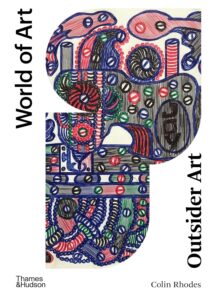
Outsider Art, Updated and Revised Edition, Colin Rhodes, Thames & Hudson, 288 pages, 200 illustrations, 2023. ISBN: 978-0-500-20486-3. Paperback $24.95
Colin Rhodes has written an accomplished survey of outsider art, its history, its current state and its future. His deep understanding of the field makes this book an authoritative and important document.
About that title: He is not defensive about the term “outsider art,” arguing that its well-established use makes it still a useful label. It’s also the name not only of Roger Cardinal’s seminal 1972 volume, but also of Rhodes’ own 2000 book (Outsider Art: Spontaneous Alternatives) of which this is a revised edition.
Rhodes brings a good deal more sophistication than usually in evidence on the question of labels and other touchy issues. Among the field’s warts that he frankly tackles is one of the original sins of art brut: primitivism.
“Like the surrealists,” Rhodes writes, “Dubuffet worked from the assumption that there existed a ‘primitive’ mentality that is innately different from the ‘civilized’ one, and that its operations were essentially mythic in character … This allowed them to draw parallels between the seemingly irrational rituals that are central to daily operations in various indigenous cultures around the world, children’s play, and many psychiatric patients.”
Of course, those parallels, as well as the primitive/civilized distinction itself, have collapsed in contemporary thinking about these issues, including Rhodes’. Art brut artists, like some indigenous artists, may envision a world that is opaque to some or all of us, but that need not imply a magical difference in their mentality. Yes, there are sometimes developmental or medical conditions that set an artist apart, but that is hardly universal.
In any case, Rhodes’ book supplies a thoughtful account of the development of the outsider art field, in part via Dubuffet’s art brut but also in the parallel (and earlier) rise of interest in self-taught art in the United States. Among the interesting points he raises is Dubuffet’s desire to keep art brut an essentially private affair. He wanted to maintain a separation from the conventional art world lest the powers that be co-opt art brut into a canon he viewed as oppressive.
That, of course, is exactly what is happening now among major museums – mostly without objection from outsider art’s leading lights, despite occasional criticisms of exactly how the co-optation is proceeding.
Rhodes addresses a number of other recurring issues that complicate the idea of outsider art. For example, the work of artists whose vision seems to put them firmly in the outsider art universe but whose technical training and accomplishment would seem to violate the rules of engagement — artists like architectural draftsman Achilles Rizzoli and professional photographer Morton Bartlett.
More generally, Rhodes is adept at articulating some of the core principles (and issues) that animate the concepts around art brut. For example: “This … awareness of a constructed pictorial world in which the creator participates fully, but which is only tantalisingly accessible to other viewers occurs in the work of two neurodivergent artists, Roy Wenzel and Dan Miller.”
That world building is, for Rhodes, the crux of outsider art, whether its source is in mental illness, obsession, developmental disability or just intense vision. He carefully covers each of those possibilities as well as exploring other fields of art, such as vernacular photography, that may seem allied to outsider art but where the work would require that additional dimension of world building to really qualify.
And the future of outsider art?
“Historically there have been only staccato displays of outsider art in significant public museums around the world,” he writes, “resulting in the constant re-enactment of a kind of eternal discovery narrative by art world insiders every time such exhibitions occur.”
Certain canonical masters like Henry Darger and James Castle might get permanently embedded in the larger art world narrative, but, he writes, “outsider art as a descriptor enables engagement in focused discourse on artistic practice conducted in the margins of the dominant art world and by persons who are additionally socially disadvantaged and/or psychologically different to putative cultural norms. Outsider art need not fear is dissolution in the mainstream. If the art world appropriates its canonical figures, it is only to enmesh them additionally in its own discourses. They are not literally taken away.”
That’s a mouthful, but insightful nonetheless. And lest it sound like the book is all about debates and issues, most of it is devoted to discussions of the field’s leading practitioners, each represented by an illustrated example of their work, which leads to the volume’s main weakness – it’s small format greatly limits the quantity and size of those illustrations.
Ultimately, though, this is a readable introduction for anyone new to outsider art and a nuanced, non-polemical accounting of the field and its main issues for those already engaged.
This review originally appeared in The Outsider magazine, published by Intuit: The Center for Intuitive and Outsider Art.
